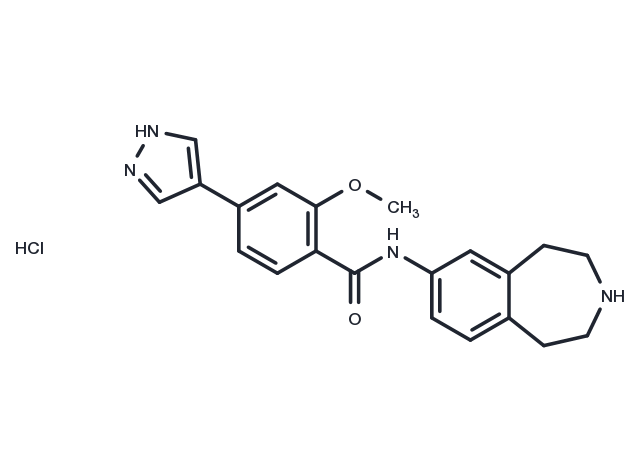Powder: -20°C for 3 years | In solvent: -80°C for 1 year


JNJ-47117096 hydrochloride is potent and selective MELK inhibitor, with an IC50 of 23 nM, also effectively inhibits Flt3, with an IC50 of 18 nM.

| Pack Size | Availability | Price/USD | Quantity |
|---|---|---|---|
| 25 mg | 6-8 weeks | $ 766.00 | |
| 50 mg | 6-8 weeks | $ 996.00 | |
| 100 mg | 6-8 weeks | $ 1,740.00 |
| Description | JNJ-47117096 hydrochloride is potent and selective MELK inhibitor, with an IC50 of 23 nM, also effectively inhibits Flt3, with an IC50 of 18 nM. |
| Targets&IC50 | MELK:23 nM , FLT3:18 nM |
| In vitro | JNJ-47117096 demonstrates selectivity in its mechanism, showing no inhibitory effects on Ba/F3 cell proliferation transfected with FGFR1, FGFR3, or KDR, irrespective of IL-3 presence. At a concentration of 10 μM (MELK-T1), it notably slows MCF-7 cell progression through S-phase and targets MELK to induce replication forks stalling and DNA double-strand breaks (DSBs), subsequently activating the ATM-mediated DNA damage response (DDR). Furthermore, at 3 and 10 μM, it initiates growth arrest and a senescence phenotype, significantly increasing p53 phosphorylation, sustained p21 up-regulation, and down-regulation of FOXM1 target genes. As a MELK inhibitor, JNJ-47117096 hydrochloride exhibits potent and selective inhibition with an IC50 of 23 nM, also effectively inhibiting Flt3 (IC50 of 18 nM) and moderately affecting CAMKIIδ, Mnk2, CAMKIIγ, and MLCK (IC50s: 810 nM, 760 nM, 1000 nM, 1000 nM). Specifically, JNJ-47117096 (MELK-T1) suppresses Flt3-driven Ba/F3 cell line proliferation with an IC50 of 1.5 μM in the absence of IL-3, showing no inhibitory activity when IL-3 is present. |
| Synonyms | MELK-T1 hydrochloride |
| Molecular Weight | 398.89 |
| Formula | C21H23ClN4O2 |
| CAS No. | 1610536-69-0 |
Powder: -20°C for 3 years | In solvent: -80°C for 1 year
DMSO: 250 mg/mL (626.74 mM)
You can also refer to dose conversion for different animals. More
bottom
Please see Inhibitor Handling Instructions for more frequently ask questions. Topics include: how to prepare stock solutions, how to store products, and cautions on cell-based assays & animal experiments, etc.
JNJ-47117096 hydrochloride 1610536-69-0 Others JNJ 47117096 hydrochloride JNJ47117096 hydrochloride JNJ-47117096 Hydrochloride JNJ 47117096 Hydrochloride MELK-T1 hydrochloride JNJ47117096 Hydrochloride MELK-T1 Hydrochloride inhibitor inhibit
